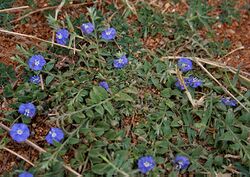Biology:Evolvulus alsinoides
| Evolvulus alsinoides | |
|---|---|

| |
| Scientific classification | |
| Kingdom: | Plantae |
| Clade: | Tracheophytes |
| Clade: | Angiosperms |
| Clade: | Eudicots |
| Clade: | Asterids |
| Order: | Solanales |
| Family: | Convolvulaceae |
| Genus: | Evolvulus |
| Species: | E. alsinoides
|
| Binomial name | |
| Evolvulus alsinoides | |
| Varieties | |
| |
Evolvulus alsinoides, commonly known as dwarf morning-glory and slender dwarf morning-glory, is flowering plant from the family Convolvulaceae. It has a natural pantropical distribution encompassing tropical and warm-temperate regions of Australasia, Indomalaya, Polynesia, Sub-Saharan Africa and the Americas.[1]
It was first described in 1753 by Carl Linnaeus as Convolvulus alsinoides.[2][3] In 1762, he transferred it to the new genus, Evolvulus.[2][4]
Description
It is a herbaceous plant, annual or perennial with numerous prostrate or ascending stems, slender, with appressed and spreading hairs. The leaves, petiolate or subsessile, are 0.7 to 2.5 cm long and 5 to 10 mm long.
The flowers are isolated or grouped in pauciflorous cymes, borne by filiform peduncles, 2.5 to 3.5 cm long. The calyx is formed by villous, lanceolate sepals 3 to 4 mm long. The rounded corolla, with pentameric symmetry, blue in color, rarely white, is 7 to 10 mm in diameter. The stamens, with filiform filaments, are united at the base of the corolla tube. The ovary, glabrous, is surmounted by two free styles. The fruit is a globular capsule, with four valves, generally containing four seeds that are black and smooth.
Habitat
The species inhabits a wide range of habitats, from marshland and wet forests to deserts. A number of varieties and subspecies are recognised. It may become a weed in some situations. It is one of the plants included in Dasapushpam, the ten sacred flowers of Kerala.[citation needed]
Chemistry
This herb used in traditional medicine of East Asia for its purported psychotropic and nootropic properties.[5] although such claims are not medically verified.
Chemical compounds isolated from E. alsinoides include scopoletin, umbelliferone, scopolin and 2-methyl-1,2,3,4-butanetetrol.[6]
References
- ↑ "Evolvulus alsinoides (L.) L.". http://pick5.pick.uga.edu/mp/20q?search=Evolvulus+alsinoides&btxt=microscope&burl=http://microscope.mbl.edu. Retrieved 25 February 2014.
- ↑ 2.0 2.1 "Evolvolus alsinoides". Australian Plant Name Index (APNI), IBIS database. Centre for Plant Biodiversity Research, Australian Government. https://biodiversity.org.au/nsl/services/rest/name/apni/87247.
- ↑ Linnaeus, C. (1 May 1753). "Petnandria Monogynia". Species Plantarum 1: 157. https://www.biodiversitylibrary.org/page/26068128.
- ↑ Linnaeus, C. (1762), Species Plantarum Edn. 2, 1: 392
- ↑ Amritpal Singh (2008). "Review of Ethnomedicinal Uses and Pharmacology of Evolvulus alsinoides Linn". Ethnobotanical Leaflets 12: 734–740. http://www.ethnoleaflets.com/leaflets/evolvulu.htm.
- ↑ "Evaluation of natural substances from Evolvulus alsinoides L. with the purpose of determining their antioxidant potency". J Enzyme Inhib Med Chem 23 (4): 574–578. 2008. doi:10.1080/14756360701674421. PMID 18666003.
External links
Wikidata ☰ Q10927597 entry
 |


